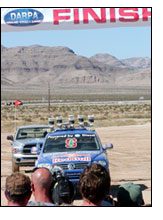PRIMM, Nev., Oct. 11 -- Stanley, a robotic Volkswagon Touareg built by Stanford University, beat other autonomous ground vehicles in the 2005 Grand Challenge race, sponsored by the Defense Advanced Research Projects Agency (DARPA).
Stanford computer scientist Sebastian Thrun led the team, which wins the $2 million prize because it finished the entire Mojave desert course in the shortest elapsed time under 10 hours -- six hours, 53 minutes and 58 seconds (6:53:58). The off-road race, which began Saturday and ended Sunday, pitted 23 autonomous vehicles on a 132-mile desert course that began and eneded in Primm, Nev. 
"Stanley" crosses the Grand Challenge finish line. (Photo: David Orenstein)
DARPA, the research and development organization for the Department of Defense, created the race to speed development of unmanned vehicles for warfare. It said the results of this year's race "demonstrated conclusively that autonomous ground vehicles can travel long distances across difficult terrain at militarily relevant rates of speed."
The first four finishers entered the history books as being the first ground vehicle robots to travel a great distance at relatively high speeds within a specified time frame. Stanley's average speed was 19.1 mph.
Only five vehicles made it through the course. With a finish time of 6:53, Stanley beat Carnegie Mellon's Red Team (7:04) and Red Team Too (7:14), The Gray Insurance Company's Gray Team (7:30) and Team TerraMax (12:51).
Stanford spent $500,000 on the race, some of which was provided by sponsors.
For more information, visit: www.darpa.mil/grandchallenge/